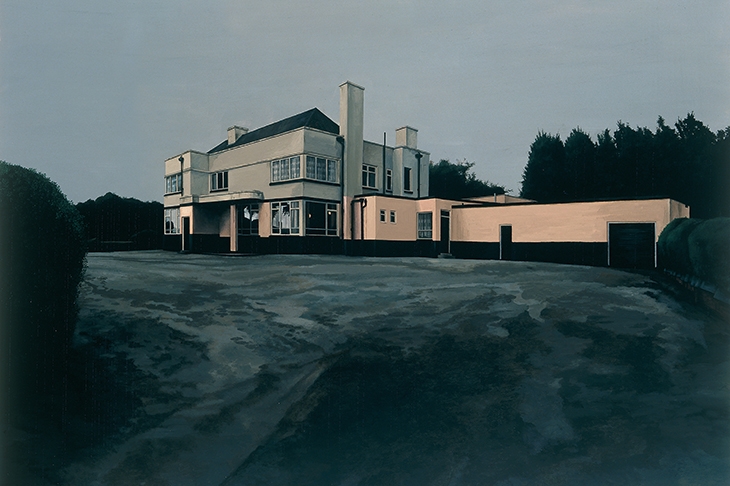All good narrative painting contains an element of allegory, but most artists don’t go looking for it on a Coventry council estate — unless, that is, they happen to come from there.
Since starting his Scenes from the Passion series while at the Royal College in the 1990s, George Shaw has been painting the Tile Hill estate where he grew up. In 20 years he has produced 200 images of the same square mile, revisiting the pubs, library and short cut to the shops of his youth, winkling out the Englishness of the place while lamenting the decline of its fabric and post-war community spirit.
Tile Hill is Shaw’s Cookham, imbued by this former Catholic schoolboy with an English mysticism more covert and far less cosy than Spencer’s. Unlike Spencer’s densely populated Cookham, Shaw’s Tile Hill appears deserted. There are no figures in his paintings, only signs of their passing. Litter caught in winter bushes by the roadside, graffiti on the boarded-up entrance to a former library, a slash of red paint scarring a tree in suburban woodland: his locations often have the look of a crime scene where a white tent might go up at any moment and forensic teams start combing the undergrowth.
The only figure in Shaw’s new Holburne Gallery show is a self-portrait, a back view of the artist pissing against a tree titled, with typical humour, ‘The Call of Nature’ (2015–16). Shaw has a working-class horror of pretentiousness: the slashed tree painting ‘Every Brush Stroke Is Torn Out Of my Body ‘(2015–16) is called after a line delivered by Tony Hancock in The Rebel. The title seems particularly absurd when applied to a canvas meticulously painted with Shaw’s usual hobbyists’ Humbrol paint. It’s a medium that gives his smaller woodland scenes, like ‘The Path Behind the Shops’ (2003), the feel of 15th-century manuscript illuminations — though that comparison comes unstuck when the subject is a 1950s pub with pretensions to art deco. Much of the show seems to be an elegy to Tile Hill’s locals, a pictorial pub crawl around the boozers of Shaw’s youth, or what’s left of them — The Hawthorne Tree roofless, The New Star flattened, a former watering hole collecting water.
A true Brit, Shaw delights in miserable weather: puddles everywhere, pub lights reflected as damp squibs in wet tarmac. The mists of memory, in his case, have a high humidity ratio. The only sunlight here shines on a flag of St George fluttering from a flagpole, but nationalism is not part of Shaw’s Englishness: the picture’s title, ‘Someone Else’s House’ (2018), lets us know that the blue skies of Brexit are someone else’s dream.
Winkling out the Englishness in modern urban living was also a preoccupation of Harold Gilman. Pallant House Gallery’s new exhibition marking the centenary of Gilman’s early death aged 43 from the Spanish flu focuses on the artist’s last decade, when his highly patterned interiors led to him being dubbed the Vuillard of London. On the evidence of this show, the first devoted to Gilman since 1982, he was better at wallpaper than intimisme. There’s precious little warmth in his paintings of his family, and after founding the Camden Town Group with Walter Sickert and becoming a socialist he turned to painting the poorer classes. But this vicar’s son was too proper to slum it: his Camden Town nudes don’t sprawl over beds like Sickert’s, they keep their knees demurely pressed together.
For social historians, Gilman is as good a guide to lower-class urban decor of the 1910s as Shaw is to 1950s estate architecture, but the self-styled ‘neorealism’ of his ‘Eating House’ (c.1914) and ‘Tea in the Bedsitter’ (1916) would convey the fragmentation of modern society better if the message wasn’t mired in claggy paint and strident colours. The French post-impressionist palette he adopted from Van Gogh didn’t travel well, turning bilious during the Channel crossing. But his reputation is redeemed in the final room with the marvellous ‘Interior with Mrs Mounter’ (1917). When the lovable figure of Gilman’s housekeeper makes her entrance through the partition doors of his Fitzrovia lodgings, she inspires a mini-masterpiece. Her sensible presence has a dampening effect on his palette; perhaps she went round with a rag and wiped it clean.
In the adjoining space, young artist Nick Goss has been given his first museum show. Another painter with a self-confessed ‘eye for tawdry detail’, Goss spreads his paint more thinly than Gilman over 7ft canvases, using turpsy washes interrupted by patches of silkscreen. The south London fast food restaurant in ‘Morley’s Mirror’ (2018) is the contemporary equivalent of Gilman’s ‘Eating House’, with the tawdry detail of a laminated menu featuring a monstrous burger oozing Day-Glo ketchup. But Goss’s urban reality is steeped, even flooded, in post-apocalyptic fantasy. The allegory in these collage-like images of a reimagined London feels like an add-on: it’s nothing personal, just picture-making.






Comments